|
Notes: Atherton Bag Lane was situated on the 8-mile Bolton & Leigh Railway (B&L) which was the first public railway to open in Lancashire. The single-track line was authorised on 31 March 1825 and ran from the important manufacturing town of Bolton to the Leigh Branch of the Leeds & Liverpool Canal at Leigh and Bedford. Engineered by George Stephenson the line opened on 28 August 1828 for goods services only. On 5 May 1826 the Liverpool & Manchester Railway (L&M) was authorised and its route passed through Kenyon which was only 2½ miles to the south of Leigh. Both the L&M and the B&L were keen to have a connection between the two lines and to bring this about a separate company, the Kenyon & Leigh Junction Railway (K&LJR) was created. A 2½-mile connecting line was authorised on 14 May 1829. The L&M opened to passengers on 15 September 1830 and was an immediate success. Less than a year later on 2 June 1831 the K&LJR opened.
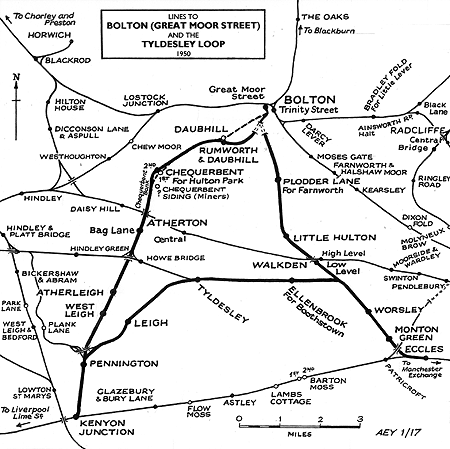 A passenger race day excursion from Bolton to Newton ran over the line on 2 June 1831 and public passenger services began on 13 June 1831. A passenger race day excursion from Bolton to Newton ran over the line on 2 June 1831 and public passenger services began on 13 June 1831.
Atherton Bag Lane opened as ‘Bag Lane’ when the public service was introduced. Located half a mile north-west of Chowbent the station served the small settlement of Bag Lane around which there were a number of collieries; the nearest, Gibfield, opened in 1829, on the east side of the line just south of the station. At the time of opening the highway that was Bag Lane crossed the line by means of a level crossing. The station was located south of the crossing on the east side of the line. It was most probably a simple cottage style building at ground level.
At the time of opening Bag Lane station had two trains in each direction between Bolton Great Moor Street and Liverpool Crown Street. Within a couple of years there were also services to Manchester.
On 4 July 1837 the Grand Junction Railway (GJR) opened between Newton (on the L&M) and Birmingham. The opening of the GJR put the Bolton line and its stations within reach of the midlands and a year later following the opening of the London & Birmingham Railway (L&B) on 9 April 1838 within reach of the capital.
The B&L and K&LJR companies allowed contractors to run trains on their lines. One such contractor was John Hargreaves Jnr who started to run passenger excursions from Bolton to Liverpool on Sundays in 1841; the services would have called at Bag Lane. In 1843 he started to run excursions to London. On 8 August 1845 the B&L, K&LJR and the L&M merged into the GJR. A year later, on 16 July 1846 the GJR merged with the L&B to form the London & North Western Railway (LNWR).
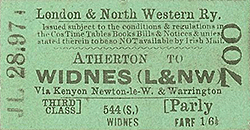 Around this time the station was renamed Atherton, a town located over a mile to the east. Around this time the station was renamed Atherton, a town located over a mile to the east.
The March 1850 timetable showed seven down (Kenyon direction) and eight up (Bolton direction) services on Monday-to-Saturday.
On 1 September 1964 the LNWR opened a railway between Wigan and Eccles. At Eccles the line connected to the former L&M route giving access to Manchester. The new line passed over the former B&L railway a mile south of Atherton station. A connecting chord of 25 chains was installed running north to east. The chord allowed trains from Bolton to run direct to Manchester without the need to reverse at Kenyon Junction. With the opening of the new line the LNWR took the opportunity to introduce a direct passenger service between Bolton Great Moor Street and Manchester Victoria which called at Atherton station.
In 1872 a second shaft was sunk at Gibfield Colliery.
On 1 April 1875 the LNWR opened a direct line between Bolton and Roe Green on the Wigan – Eccles railway. This improved the journey times between Bolton and Manchester but it meant that fewer Manchester trains ran via Atherton.
During the 1880s the LNWR made improvements to the line. They included the creation of diversions from two inclined planes (at Chequerbent and at Daubhill), the rebuilding of Bolton Great Moor Street station and the creation of a double-track route. The line through Atherton (between Pennington Junction and Atherton Junction) became double track on 31 May 1880.
Atherton station was also improved at this time. The level crossing was taken away and on the eastern side of the line Bag Lane was diverted to run northwards (parallel to the line) for a hundred yards. It then turned sharply to the west passing under the line after which it picked up its original alignment. The new section of road on the east side of the line was called Railway Street. The road alterations allowed a larger station to be constructed. Platforms were constructed which extended northwards beyond the point where the level crossing had been.
The main facilities were still on the up side of the line. They were housed in a single-storey, brick structure fronted by a substantial hipped ridge-and-furrow awning.
On the down platform (Bolton direction) there was screen wall supporting an awning that complemented that on the up platform.
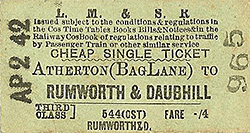 A subway provided access to the station and linked the platforms. It was necessary because a goods line passed to the rear of the down platform isolating it from the road - goods sidings also passed to the rear of the up platform. The subway also provided a pedestrian route to compensate for the loss of the level crossing. A subway provided access to the station and linked the platforms. It was necessary because a goods line passed to the rear of the down platform isolating it from the road - goods sidings also passed to the rear of the up platform. The subway also provided a pedestrian route to compensate for the loss of the level crossing.
A signal box was provided on the down platform south of the station building.
Goods facilities were also expanded. Sidings, a large goods shed, a weighing machine and crane were located east of the passenger station. Access to the goods facilities was via a gate on Bag Lane.
By this time Gibfield Colliery had more than doubled in size. Sidings connected to it from the goods yard and also from the down line.
The December 1895 timetable showed 14 up trains on Monday-to- Saturday as seen in the table below. There were also three up trains that terminated at Atherton. There were 21 down services on Monday-to-Saturday. Most of the Manchester trains commenced their journey at Atherton. On Sunday there were three trains in each direction all of which ran between Bolton and Manchester via Tyldesley.
Up Trains – December 1895 |
Destination |
Down Trains – December 1895 |
Destination |
8.17am |
Bolton Great Moor Street |
6.01am |
Manchester Exchange |
9.04am |
Bolton Great Moor Street |
8.14am |
Kenyon Junction |
10.03am |
Bolton Great Moor Street |
8.52am |
Kenyon Junction |
10.05am |
Terminating train from Manchester Exchange |
8.56am |
Manchester Exchange |
10.51am |
Terminating train from Manchester Exchange |
9.27am |
Kenyon Junction |
10.55pm |
Bolton Great Moor Street |
9.52am |
Manchester Exchange |
11.42pm |
Bolton Great Moor Street |
10.47am |
Kenyon Junction |
1.24pm |
Bolton Great Moor Street |
10.52am |
Manchester Exchange |
1.56pm |
Bolton Great Moor Street |
12.49pm |
Warrington Bank Quay |
2.57pm |
Bolton Great Moor Street |
1.32pm |
Manchester Exchange |
4.04pm |
Bolton Great Moor Street |
2.32pm |
Kenyon Junction |
5.02pm (Saturdays Only) |
Terminating train from Manchester Exchange |
2.40pm |
Manchester Exchange |
5.05pm (Saturdays Excepted) |
Terminating train from Manchester Exchange |
4.27pm |
Kenyon Junction |
5.18pm |
Bolton Great Moor Street |
4.32pm |
Tyldesley |
5.52pm |
Bolton Great Moor Street |
5.22pm |
Kenyon Junction |
6.55pm |
Bolton Great Moor Street |
5.25pm |
Manchester Exchange |
9.22pm |
Bolton Great Moor Street |
6.07pm |
Kenyon Junction |
9.53pm |
Bolton Great Moor Street |
7.37pm |
Manchester Exchange |
|
|
8.42pm |
Kenyon Junction |
|
|
9.43pm |
Manchester Exchange |
|
|
11.03pm |
Manchester Exchange |
The 1904 Handbook of Stations listed Atherton as being able to handle public goods, parcels, livestock and horse boxes. The station was shown to have a 10-ton lifting crane.
On 1 January 1923 the LNWR was merged with other companies to form the London Midland & Scottish Railway (LMS). On 2 June 1924 the LMS renamed the station Atherton Bag Lane.
The LMS Summer timetable for 1932 showed 19 up trains on Monday-to-Friday. On Saturday there were xx up services. In the down direction there were 19 trains on Monday-to-Friday. Four of the down trains took the Tyldesley route and the other 15 went in the Kenyon Junction direction. There were additional trains on Saturday but Atherton Bag Lane had lost its Sunday service by this time.
During the Second World War passenger services were reduced and they never returned to their 1930s levels. The LMS summer timetable for 1947 showed eight down and seven up Monday-to-Friday services. There was one extra down and two additional up trains on Saturday. No trains called at Atherton Bag Lane on Sunday. The first train was an up service for Bolton Great Moor Street which departed at 6.56am. The last was also an up service to Bolton which departed at 9.23pm. By this time there were no trains running to and from Manchester via Tyldesley.
On 1 January 1948 the line became part of British Railways [London Midland Region] (BR[LMR]).
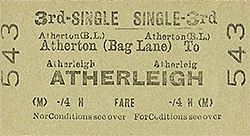 The 1953 summer timetable showed seven down trains on Monday, Wednesday and Friday. There were eight down trains on Tuesday and Thursday and ten on Saturday. In the up direction there were six trains on Monday, Wednesday and Friday. On Tuesday and Thursday there were seven trains and on Saturday nine. The 1953 summer timetable showed seven down trains on Monday, Wednesday and Friday. There were eight down trains on Tuesday and Thursday and ten on Saturday. In the up direction there were six trains on Monday, Wednesday and Friday. On Tuesday and Thursday there were seven trains and on Saturday nine.
BR[LMR] closed Atherton Bag Lane station to regular passenger services on 27 March 1954 but it continued to operate as a goods station. The 1956 Handbook of Stations listed it as able to handle general goods and as having a 10-ton lifting crane.
The station was used after formal closure for holiday specials and excursions. The last year that holiday trains ran was 1958, when on 28 June there was a departure for Llandudno at 11.42am and on Saturday 5 July a train left for Bangor at 8.10am.
On 17 June 1963 the line between Pennington and Howe Bridge North Junction closed completely; thereafter trains could reach Atherton Bag Lane only via the Wigan – Eccles line. A few months later on 7 October 1963 Atherton Bag Lane was closed completely.
On 6 January 1969 the line through Atherton Bag Lane closed completely. It was lifted shorty after and the station was demolished. After closure Bag Lane was restored to its pre-1880 alignment.
Tickets from Michael Stewart and route map by Alan Young.
Sources:
- A Lancashire Triangle Part 2 - D J Sweeney, Triangle Publishing 1997.
- A Regional History of the Railways of Great Britain - Volume 10 The North West - Geoffrey O Holt, David & Charles 1986.
- Forgotten Railways - North West England - John Marshall, David & Charles 1981.
- Railway Passenger Stations in Great Britain - A Chronology, by M Quick, RCHS 2009.
See also: The Bolton & Leigh Railway
To see the other
stations on the Bolton Great Moor Street - Kenyon Junction line
click on the station name: Kenyon
Junction, Pennington, West Leigh,
Atherleigh, Chequerbent
1st, Chequerbent
2nd, Daubhill 1st,
Rumworth
& Daubhill & Bolton
Great Moor Street |

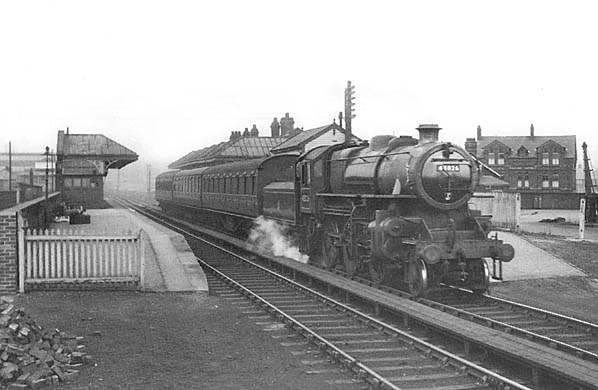
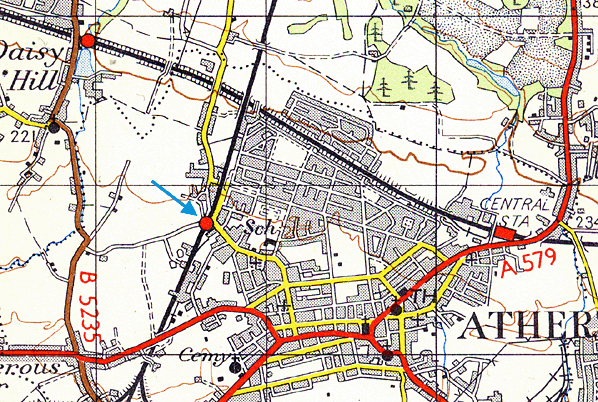
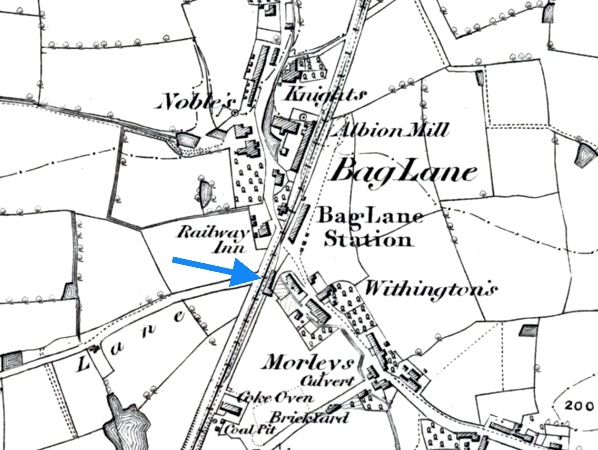
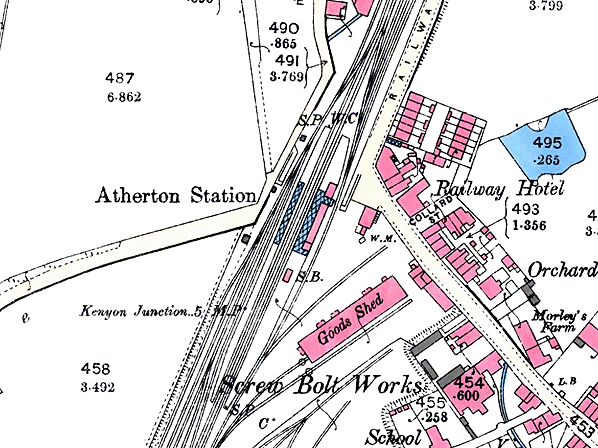
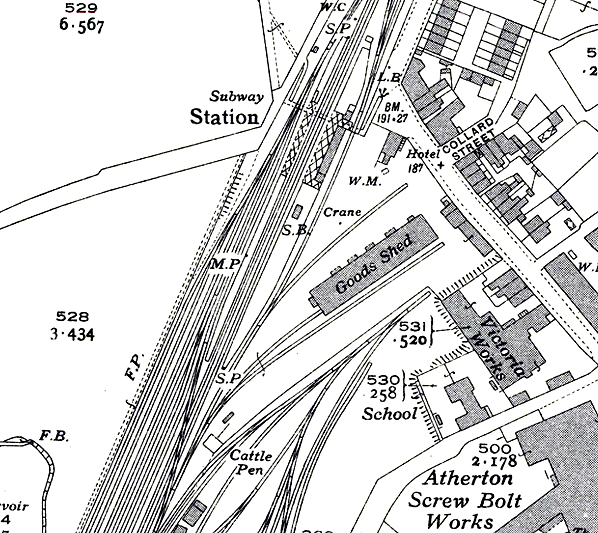
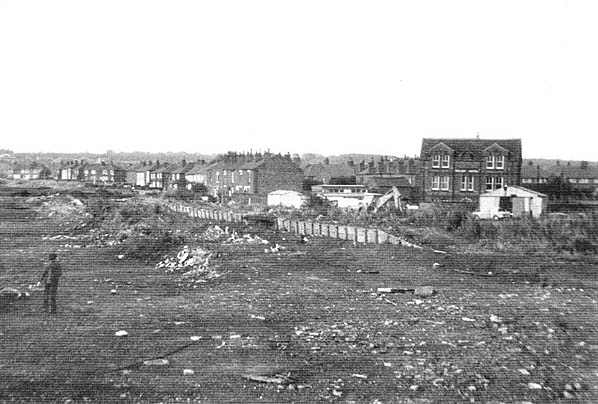
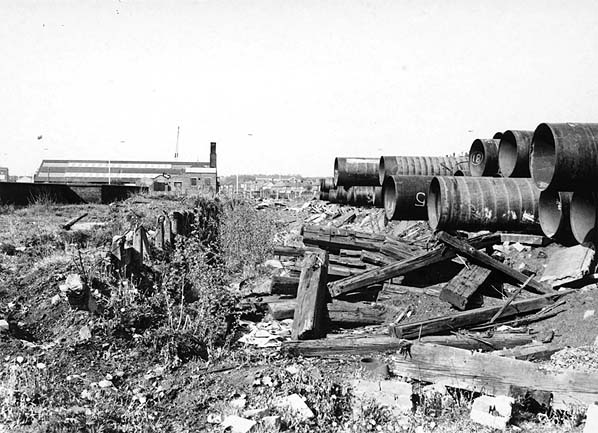
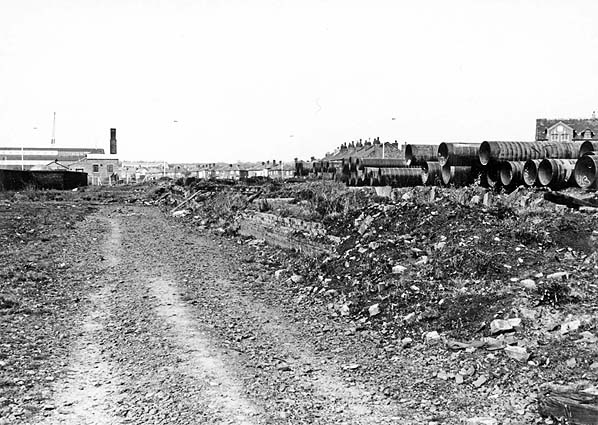
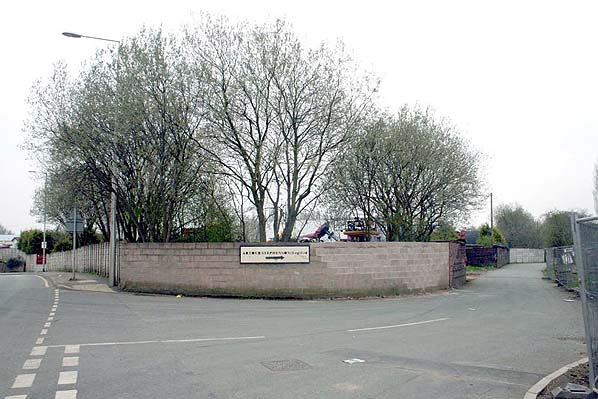
 Home
Page
Home
Page
 A passenger race day excursion from Bolton to Newton ran over the line on 2 June 1831 and public passenger services began on 13 June 1831.
A passenger race day excursion from Bolton to Newton ran over the line on 2 June 1831 and public passenger services began on 13 June 1831.  Around this time the station was renamed Atherton, a town located over a mile to the east.
Around this time the station was renamed Atherton, a town located over a mile to the east.  A subway provided access to the station and linked the platforms. It was necessary because a goods line passed to the rear of the down platform isolating it from the road - goods sidings also passed to the rear of the up platform. The subway also provided a pedestrian route to compensate for the loss of the level crossing.
A subway provided access to the station and linked the platforms. It was necessary because a goods line passed to the rear of the down platform isolating it from the road - goods sidings also passed to the rear of the up platform. The subway also provided a pedestrian route to compensate for the loss of the level crossing.  The 1953 summer timetable showed seven down trains on Monday, Wednesday and Friday. There were eight down trains on Tuesday and Thursday and ten on Saturday. In the up direction there were six trains on Monday, Wednesday and Friday. On Tuesday and Thursday there were seven trains and on Saturday nine.
The 1953 summer timetable showed seven down trains on Monday, Wednesday and Friday. There were eight down trains on Tuesday and Thursday and ten on Saturday. In the up direction there were six trains on Monday, Wednesday and Friday. On Tuesday and Thursday there were seven trains and on Saturday nine. 

